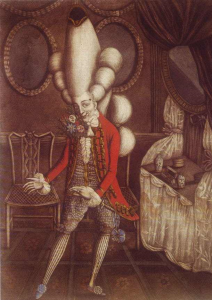krakow
 Most people, men anyway, think that it is only women who are fashion conscious to a fault. While many women are very fashion conscious, so are many men, and the fashions that some of the men wore can be just as dangerous. When fashion consists of the wearing of articles of clothing or accessories that have the ability to cause death or injury, we are in danger of sacrificing too much in the name of fashion.
Most people, men anyway, think that it is only women who are fashion conscious to a fault. While many women are very fashion conscious, so are many men, and the fashions that some of the men wore can be just as dangerous. When fashion consists of the wearing of articles of clothing or accessories that have the ability to cause death or injury, we are in danger of sacrificing too much in the name of fashion.
Some fashions do no harm, but looking back on them, we can see just how silly they looked. Nevertheless, powdered wigs were in fashion for men in several different centuries. Long hair was considered a show of status, for both men and women over the years. In ancient Greece, long male hair was a symbol of wealth and power, while a shaven head was appropriate for a slave. The problem occurred when the person, usually the men, but women too, had thinning hair. If their social status depended on that hair, they would need a way to fix the problem when it did not exist. The powdered wig helped with that, and some men wore their wigs in very elaborate styles. In the 1760s, aristocratic British men donned large wigs with a small hat or feather at the top. The young men who took up this fashion trend reportedly brought it back from their “Grand Tour” across Continental Europe in which they intended to “deepen cultural knowledge.” The style is, in fact, named after the Italian pasta dish…macaroni, signifying sophistication and worldliness. It is here that we get the song many of us have wondered about called, “Yankee Doodle,” the lyrics of which pointed out that the feather on top was supposedly called macaroni.
The shoes of the men have taken some strange turns as well. Known as the Poulaine, this super long shoe  reigned supreme with men across Europe in the late 14th century. The shoes, called Crakow were named after Krákow, Poland because they were introduced to England by the Polish nobles. Once the shoes were seen at court, they became all the rage…even though the shoes were six to twenty four inches long. I’m sure you are thinking to yourself, “Who would be crazy enough to wear these?” Well, I’ll tell you that current styles (or maybe just a year or so in the past) saw women, and men too, wearing shoes that had an extra long pointed toe, so it isn’t just an oddity of 14th century Britain. The shoes were a quick indicator of social status…the longer the shoe, the higher the wearer’s station. Some of these shoes were so long that chains were sometimes strung from the toe of the Crakow to the knee to allow the wearer to walk. Other times the toes were stuffed with material for the same reason, making the toes stiff. The strange shoes were considered ridiculous, vain, and dangerous by many conservatives and church leaders, who called them “devil’s fingers.”
reigned supreme with men across Europe in the late 14th century. The shoes, called Crakow were named after Krákow, Poland because they were introduced to England by the Polish nobles. Once the shoes were seen at court, they became all the rage…even though the shoes were six to twenty four inches long. I’m sure you are thinking to yourself, “Who would be crazy enough to wear these?” Well, I’ll tell you that current styles (or maybe just a year or so in the past) saw women, and men too, wearing shoes that had an extra long pointed toe, so it isn’t just an oddity of 14th century Britain. The shoes were a quick indicator of social status…the longer the shoe, the higher the wearer’s station. Some of these shoes were so long that chains were sometimes strung from the toe of the Crakow to the knee to allow the wearer to walk. Other times the toes were stuffed with material for the same reason, making the toes stiff. The strange shoes were considered ridiculous, vain, and dangerous by many conservatives and church leaders, who called them “devil’s fingers.”
In the 19th century, men began wearing detachable collars, that were heavily starched until they were quite stiff. While the collars didn’t look all that odd, they could be deadly. Because they were so heavily starched, taken to the extreme of the collar being nearly unbendable, and because they were attached with a singular or  pair of studs, the collar could slowly asphyxiate a man, if he fell asleep or passed out while drinking. It had a similar effect to a cord being wrapped tightly around the poor man’s neck. Another dangerous aspect of the collar was its pointed corners. A Saint Louis man, wearing one of these collars, tripped in the street and the pointed corners of the collar jabbed into this throat, “making two ugly gashes.” If the gash happened to be in the vicinity of the Jugular vein, death could come quite quickly. These collars were so lethal, in fact, that they were known as “the father killer.” I can only imagine how many women and children pleaded with their husbands or fathers not to wear the collar, which maybe should have been called the choker.
pair of studs, the collar could slowly asphyxiate a man, if he fell asleep or passed out while drinking. It had a similar effect to a cord being wrapped tightly around the poor man’s neck. Another dangerous aspect of the collar was its pointed corners. A Saint Louis man, wearing one of these collars, tripped in the street and the pointed corners of the collar jabbed into this throat, “making two ugly gashes.” If the gash happened to be in the vicinity of the Jugular vein, death could come quite quickly. These collars were so lethal, in fact, that they were known as “the father killer.” I can only imagine how many women and children pleaded with their husbands or fathers not to wear the collar, which maybe should have been called the choker.
I can understand the need of people to have a certain fashion sense, as I am also one who likes to look up to date and to have a good fashion sense too, but people really need to also consider their own safety when it comes to style. It pays to listen to others who might know something about this certain idea of fashion, that could not only benefit you, but possibly save your life.
 We have all heard of the atrocities that took place in Nazi Germany regarding the Jewish people. And many people might have seen the movie called Schindler’s List. When the movie came out, I did not have a real interest in the old war movies, but I really should have in this one, because it is not your typical war movie. The movie documents the actions of a member of the Nazi Party, who saw something that was morally wrong, and did something about it.
We have all heard of the atrocities that took place in Nazi Germany regarding the Jewish people. And many people might have seen the movie called Schindler’s List. When the movie came out, I did not have a real interest in the old war movies, but I really should have in this one, because it is not your typical war movie. The movie documents the actions of a member of the Nazi Party, who saw something that was morally wrong, and did something about it.
Schindler wasn’t what would be considered a moral upstanding citizen to the Christian way of thinking. He married Emilie Pelzl at nineteen, but was never without a mistress or two. When his family’s business went under, he presided over the the proceedings, and then became a salesman when opportunity came knocking in the form of the war. Schindler was never one to miss a chance to make money. He saw opportunity in Poland, so he marched in on the heels of the SS. Soon, he was deep into the black-market and the underworld..making friends with the Gestapo officials along the way…softening them up with women, money and illicit booze.

It was his newfound connections that helped him acquire the factory in Krakow during the German occupation of Poland, which he ran with the cheapest labor around…namely the Jewish people from the nearby Jewish ghetto. Schindler was a hard man, and didn’t care much about others, but somewhere along the line, something changed. When the Nazis decided to liquidate the ghetto, he persuaded the officials to allow the transfer of his workers to the Plaszow labor camp. I’m not sure what they workers thought of that situation right away, but in the end, to saved them from deportation to the death camps, for which they were grateful.

By 1944, Hitler had become more and more crazed, and all the Jews at Plaszow were to be sent to Auschwitz, but Schindler couldn’t bear to see his workers murdered by Hitler. Schindler decided to take a huge risk, and bribe the officials into allowing him to keep his workers and set up a factory in a safer location in occupied Czechoslovakia. Miraculously, they agreed to let him have his workers, probably thinking of the factory’s production, and not the fact that these Jews would not meet the horrible fate awaiting them in the death camps. So, Schindler gave them a list of his workers, and of course, that is where the name of the movie came from. By the war’s end, Schindler was penniless, but he had saved 1,200 Jews. And that makes him a very rich man, indeed. In 1962, he was declared a Righteous Gentile by Yad Vashem, Israel’s official agency for remembering the Holocaust. Oskar Schindler died on this day, October 9, 1974, and according to his wishes, he was buried in Israel at the Catholic cemetery on Mount Zion.

